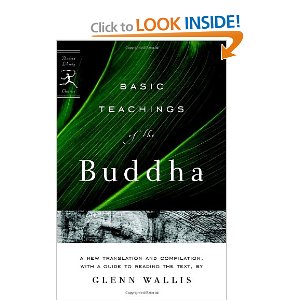Basic Teachings of the Buddha
I’ve just finished reading Basic Teachings of the Buddha by Glenn Wallis for the second time, and I must say I really like this book. In fact, I wish I had had it years ago when I first started my exploration into Buddhism. I will be referring to this book in years to come.
So many books tend to over-complicate Buddhism, make it hard to discern exactly what the practice is, and what we get out of it. Additionally, many books I’ve read have made the Buddhism seem magical, like meditation brings us to some higher spiritual (whatever that means) state of mind. Very often after reading some book, I was left wondering what I had just read.
Glenn not only explains the teachings of the Buddha in plain, modern day English, he has translated 16 suttas that reveal the foundational teachings of the Buddha. I really like this format of having open commentary, some history of Buddha and Buddhism, explanation of what the suttas are, and then 16 specifically chosen suttas that clearly explain the most important teachings of the Buddha.
I have read The Middle Length Discourses of the Buddha by Bhikkhu Bodi, and while I do continue to read them, as well as those translated by other authors on Access to Insight, I find many of those suttas to be tedious to read, overly long, and filled with cultural details not necessary to the teachings. I completely understand why they are filled with the endless repetition. The suttas had been an oral tradition, and nothing helps memory like repetition. But what I also find difficult is some of the language and the wording. Sometimes it’s just confusing to understand what is intended in the wording.
Over the years, I have discovered from various people who are learning Pali and doing some of their own translations, that many Pali words have multiple meanings, are used in a variety of ways, depending on context, and therefore the suttas message sometimes varies. Of course, this is not surprising.
What I like about Glenn’s selection and translations is that each of these texts exemplify a specific teaching, and he uses modern language that I can understand. He has left out the pointless (in modern day context) repetition, and cultural detail that can be distracting. Even better, he follows the texts with what he calls Guide to Reading the Texts. For each sutta, Glenn has provided helpful commentary on the teaching and notes regarding some of the terms and their uses.
My only criticism is that I would have preferred to read a sutta and have the commentary immediately follow, instead of all the suttas, followed by all the commentary for each text.
Perhaps over time we will see many more translations of the Pali Canon suttas. I hope so. I think we have for too long had to go by the same volumes. It’s nice to see new translations through people who are not monks, or caught up within certain traditions. Something that comes through well in Basic Teaching of the Buddha is how very practical the Buddha was, how secular and agnostic, and also how doable the practice is, how it helps sit us in the heart and reality of our existence.
I’m hoping, hint, hint, that Glenn will write another similar book, with a new set of suttas that build on or reiterate the basics. In the meantime, I’m now looking forward to reading his translation of The Dhammapada: Verses on the Way.

